The secret of purple glass
The secret of purple glass is based on the fact that the harmful spectral domain of light is filtered and removed. The protective effect of violet glass has been confirmed by biophotonic measurements by Dr. Hugo Niggli of the Institute for Biophysics of Prof. Fritz Popp since 1996. Another series of tests, performed in 1997 at the institute by Dr. Dieter Knapp, impressively confirms the effectiveness of purple glass.
The advantages of MIRON violet glass
- Significantly better protection against the influence of light – Maintenance and stimulation of bioenergy
- Extension of shelf life
- Possible reduction of preservatives
- Attractive, reusable packaging MIRON violet glass
- Quality through light protection and, implicitly, bioenergy preservation
Information on violet glass
How do we protect quality? Do you want to keep high quality food or healing products in the best possible conditions?
In this case, you are probably trying hard to get the best quality and efficiency for your products. In order to maintain their level of value and quality, vital energy with its potential information must be adequately protected. The most commonly used packaging material for this purpose is traditionally brown glass and plastic. These materials are often inadequate to sufficiently protect the etheric energies of your precious products. Practical experience demonstrates decreases in quality and efficiency after several months of storage.
This loss of quality can be avoided. There is now a packaging material that can maintain the bioenergetic value of your precious products for a long time at the initial level: MIRON violet glass. This bottle provides optimal protection for your products.
MIRON violet glass is currently the only known medium that protects products from the influence of the visible part of the light spectrum (except violet light) and, at the same time, is permissible for light from the UV-A and infrared (IR-A) fields of the electromagnetic spectrum. invisible!
Preservation of high-value substances has been a concern since ancient cultures. In pre-Christian Egypt, noble essences and medicines were stored in gold or purple containers. The high level of quality protection, characteristic of violet glass, is also mentioned in the works of the Austrian mystic Jakob Lorber from Graz (1800-1864).
In our modern times, new forms of packaging have developed that often accompany loss of quality during storage. The profound wisdom of ancient cultures has become more and more true with the latest results of modern research in the field of light (biophotonics):
Light plays a decisive role for all living beings in the exchange of energy and information. This bioenergy must be optimally protected, similar to the situation in ancient Egyptian culture. MIRON violet glass was scientifically examined by Swiss biophotonics researcher Dr. Hugo Niggli. He summarizes his results as follows:
Samples deposited in MIRON violet glass show minimal energy loss. The quality of the products kept for a period of several months in this optimal protective glass is significantly better, compared to the conventional colored glass.
MIRON bottle
stores energy Considering the optimal protection of quality, in a long research work, of the order of years, the MIRON violet glass was elaborated. The experimental knowledge of the ancient Egyptians in preserving high value products was clustered with scientific knowledge in the new field of light research, resulting in the development of a unique quality bottle, purple color: MIRON purple glass.
The scientific basis of the knowledge about MIRON violet glass lies in the principles of biophotonics. From the early twenties, the Russian researcher Alexander G. Gurvici (1874-1954) discovered with the help of a biological experiment an ultra-weak cellular radiation in onion cells in the dividing phase. He postulated that there is a communication between living things and light radiation. In the early 1970s, German biophysicist Fritz-Albert Popp, Japanese researcher Inaba, and Australian naturalist Quickenden independently confirmed this cellular radiation (biophotons) with highly light-sensitive measuring instruments through modern naturalistic experiments.
Modern research in light reveals that all living cells emit weak light radiation, but with orderly properties.
Measurements show that violet light has the highest oscillation frequency of all colors, namely 750 trillion Hertz. Interestingly, cells and food can activate their biophotonic radiation especially in this field and in the bordering UV-A spectrum, in which violet glass also has permissiveness. This discovery is based on the results of cell radiation researcher German Fritz-Albert Popp. He emphasizes the importance of UV-A / violet communication processes and sees the hereditary structure, known so far only as a carrier of hereditary properties, as an important source of this biological electromagnetic radiation. Cell biologist Guenter Albrecht-Buehler deciphers with his scientific work the cellular interaction through infrared radiation. Research in the field of biophotonics emphasizes that, in living matter, light has a high degree of order and, therefore, can transmit information. Interestingly, only the healthiest foods have these so-called “most consistent light emissions.” This coherence is considered as a measurement quantity for the bioenergetic force, which appears together with the efficiency of the products. That is why it becomes clear that our diet is based on taking up the coherent light energy stored in plant and animal substances, as well as on its optimal use.
The theory and the first scientific research on biological samples kept in violet glass indicate a favoring of this ordering property and the transmission of information.
This amazing effect is most likely based on the special combined transparency of MIRON violet glass in the UV-A / violet and IR fields.
MIRON bottle
The influence of light
Sunlight consists on the one hand of the visible spectrum (with the colors of the rainbow) and on the other hand of the invisible ultraviolet and infrared spectrum (image 1). Sunlight is vital for the growth of all plants. Once they are ready for harvest, they must be used immediately or stored properly. If they are still exposed to the sun after ripening, the degradation process begins. The same light, which first allowed growth, now accelerates the process of molecular decomposition and reduces bioenergy.
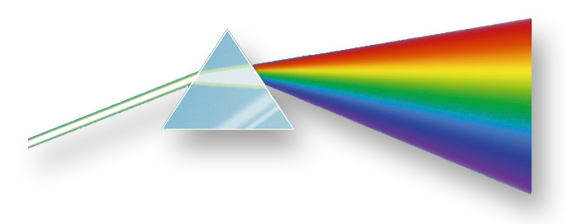
Light spectrum
When light falls on a prism, the colors of the spectrum become visible. Colors with a higher frequency, e.g. violet (measured in Hertz) has a short wavelength (measured in nanometers), and low frequency colors have a long wavelength. Ultraviolet and infrared light are not visible.
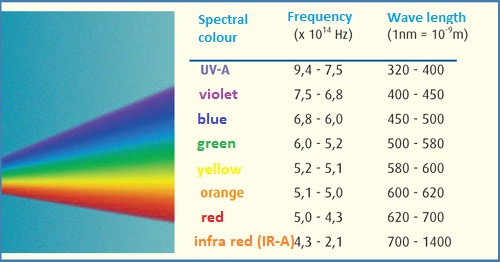
Traditional packaging material
Most products are packaged in practice in conventional plastic or colored glass containers. Plastic is a modern industrial product that can provide good protection against light. Of course, in most cases, it is not permissive to the UV-A and violet domain, which is important for the intercellular exchange of information. Today, most valuable foods, such as wines or noble oils, are still stored in stained glass packaging. The presence of plastic in the packaging industry is primarily explained by the considerably lower fragility and lower mass of plastic products. However, some plastic containers are porous, unlike glass, which can lead to oxidation of the biological samples contained, with losses of appropriate quality.
MIRON bottle
Glass is generally recommended as a nobler product than plastic. However, from the transmission measurements illustrated (Figure 1) it is observed that, depending on the thickness of the glass, both white glass and stained glass are permissive to visible light (except black glass) and therefore do not provide sufficient protection.
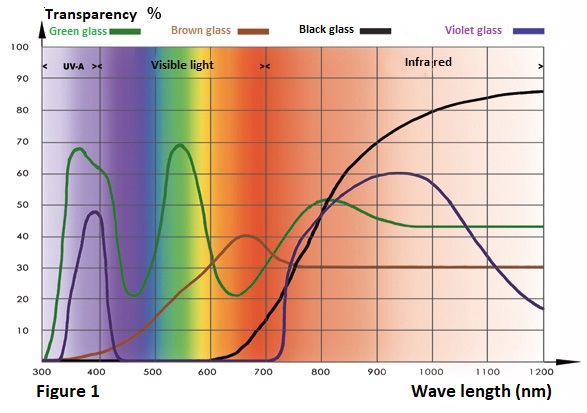
Comparison with MIRON violet glass
Green glass is relatively light in the UVA field, but also in the visible field of light (image 2). Brown glass, very commonly used in the pharmaceutical industry, is impermissible to UV-A light, but does not provide sufficient light protection in the rest of the spectral range (Figure 3).
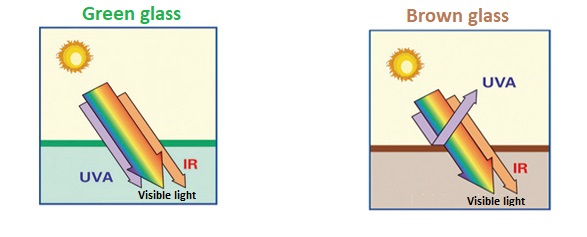
Black glass is, like violet glass, impermissible in the visible field. However, it does not allow light to pass through the UV and violet domains (image 4) and, therefore, is not characterized by the ordering of an important communication field. Seen from the outside, the purple MIRON bottle looks almost black. The specific purple color becomes visible only when held in front of the eyes in sunlight. From the 4 + 5 images it is clear that the resemblance to black glass is purely external.
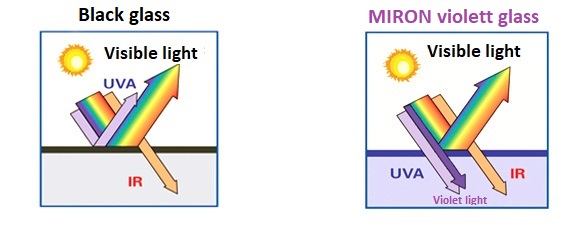
MIRON bottle
The effect of MIRON purple glass
MIRON purple glass offers only absolute protection against visible light except for violet light, but also has a transparency provided in the UV-A / purple range on the one hand and in the IR range on the other. This unique combination only reduces the accelerated light-altering processes in the visible spectral range, but further supports the maintenance of the light energy mentioned at the beginning in the UV-A / violet and infrared fields. This keeps the highly ordered structure of the food, and the bioenergy is maintained for a long time at the initial level. The molecular structures of the substances stored in violet glass remain permanently vitalized by the two spectral domains. This gives the purple bottle an optimal quality for storage. More scientific information (in German) on the subject of light is provided in the informative material Was ist Licht, by Dr. Hugo Niggli.
Biophotonic measurements with food
At the Internationalen Institut für Biophysik IIB in Hombroich bei Düsseldorf (Germany), under the direction of Professor Fritz-Albert Popp, a fundamental research work was carried out in the field of biophotonic analysis applications for food and medicines, which was initiated at the beginning in the 1980s at the University and Technology Center of Kaiserslautern. From the results so far it can be concluded that the level of food quality depends not only on the chemical composition, but essentially on the content of light energy and potential information. Biophotonic measurements show that food (fresh, pressed or dried cereals, plants and fruits) and plant extracts (eg olive oil and flaxseed oil) are excellent reservoirs and suppliers of light energy. The more food a food can store and transmit, the more valuable it is in terms of quality, so that all living cells emit low light radiation, but with orderly properties. However, food loses its light energy in the storage process and deteriorates prematurely (Figure 6).
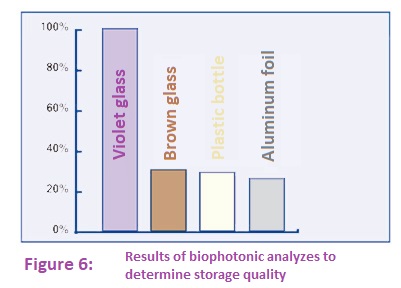
Dr. Niggli, who has been collaborating on scientific projects with Professor Popp since 1988, began biophotonic research on foods stored in violet glass in the mid-1990s (Figure 8). Regarding the first biophotonic measurements on food in purple glass, Dr. Niggli briefly reported the following: the energy quality and order of food kept in purple glass were significantly better compared to conventional colored glass and plastic containers. In addition, the optimal protection of bioenergy during long-term storage for several months has been demonstrated experimentally.
MIRON bottle
The photo of the energy penny Everything in nature radiates energy. The energy radiation emitted by a living being or substance shows the amount of energy that exists. The human eye cannot perceive these energy fields. The German researcher Dr. Dieter Knapp developed in his institute a special electrography procedure, with which the energy fields can become visible photographically. In Dr. Knapp’s laboratory, the spirulina algae from the same production batch were introduced in various packages, and after four weeks the measurement was made: the violet glass sample has an intense and dynamic energy field, while the brown glass samples and plastic there is a clear decrease in energy field.

Miron glass sets new standards
The main factor for the quality of food and medicine is the content of light energy and potential information. In the processes of industrial processing of products, the natural protection present for example in the case of nuts is lost in most cases. In this way, due to biological degradation processes, even high quality products deteriorate significantly faster and record a loss of energy quality, caused by the action of light in the visible spectral range. It is not for nothing that the consumer is often advised to keep the products in cool, dry and dark places, because, unfortunately, many packages do not offer sufficient protection against the influence of light. Purple glass with energy storage properties offers completely new perspectives to manufacturers of high quality products. It allows maintaining an optimal level of quality and efficiency for biological substances, as well as effective protection. Quality products deserve a valuable quality packaging such as Miron glass, so that optimal quality at the end of production can be guaranteed until long-term storage at the consumer.
Miron glass – production and sale
The optimal protective effect of MIRON violet glass is attributed to a specially elaborated and patented glass recipe. Detailed studies have been conducted to define this shade of dark purple. A layer of paint is not simply applied, but the glass is completely colored. Color pigments are melted to a certain extent in the glass mass. MIRON violet glass is 100% recyclable (can be deposited in glass containers). In our opinion, the best solution is to continue to use MIRON quality glass to store light-sensitive substances. On request, MIRON violet glass can be produced in virtually any shape and size (in large quantities). Violet glass is accompanied by a wide range of accessories, such as caps and threaded fasteners with a purple insert. They contain a plastic insert made especially for MIRON glass, covered on both sides with a purple MIRON foil. This purple insert provides extra protection for high quality products.
Gold makes you more beautiful – a boost for connective tissue
Colloidal gold has a spectacular effect on connective tissue and skin. We discuss this effect in the context of an important factor for skin and tissue aging: sugar. Consuming large amounts of sugar increases your insulin levels a lot. The result is a chain of reactions that ultimately negatively affects the connective tissue and the skin. Blood sugar levels increase, which leads to the adhesion of collagen fibers. The cause of this phenomenon is the so called AGE (Advanced Glycation End-products), uncontrolled reactions of sugar with proteins and lipids, which produce a strengthening of collagen fibers and cause the skin and connective tissue throughout the body to lose elasticity.
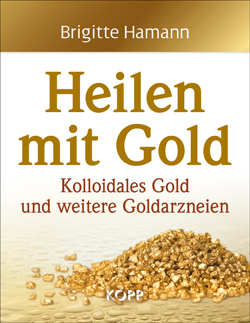
Healing with gold – colloidal gold and other gold cures, a very interesting book written by journalist Brigitte Hamann, specializing in health, published by the German publishing house KOPP in 2014
The consequences are the laxity of the skin, as well as the multiplication and deepening of wrinkles. AGEs are deposited in the blood vessels and can cause calcifications, and the functioning of the cells and the body’s own reaction system is disrupted, which accelerates the aging of cells. This process that has them between sugar and protein is called “glycation”. An advanced glycation leads to inflammation in the cells, the symptoms being, among other things, itching on the skin, eczema and allergic reactions.
Research shows that colloidal gold has an anti-glycation effect. A study conducted in 2011 at the University of Seoul, South Korea, can be viewed here:
https://www.researchgate.net/publication/221794610_Anti-glycation_Effect_of_Gold_Nanoparticles_on_Collagen
An article on long-term research, which shows a significant decrease in the distances between tissue fibers (40 percent) under the influence of gold nanoparticles, can be found here.
http://www.ncbi.nlm.nih.gov/pmc/articles/PMC1501007/
Colloidal silver versus Staphylococcus aureus

In 2016, at the Cantacuzino Institute in Bucharest, we tested a sample of colloidal silver produced in our laboratory, with a concentration of 138 ppm. We aimed to evaluate the bactericidal activity in accordance with the European standard SR EN ISO 1276: 2010, which determines whether or not an antiseptic or disinfectant has bactericidal activity and whether it can be used in the agri-food, industrial, domestic and community fields. These areas include, according to the standard, food processing and distribution activities (milk, dairy, meat and dairy products, eggs, fish, plant foods, bakery products, etc.), restaurants, public transport, schools, kindergartens, shops , gyms, hotels, areas of clinically insensitive hospitals, industrial areas where they work with pharmaceuticals, cosmetics and body hygiene, etc.
- Bactericidal activity was evaluated on the following four test microorganisms:
- Staphylococcus aureus
- Pseudomonas aeruginosa
- Enterococcus hirae
- Escherichia coli (E.coli)
The test simulates:
- Sterile conditions: by dissolving bovine albumin for microbiological uses and obtaining a solution of low concentration 0.3 g / l.
- Dirt conditions: by dissolving bovine albumin for microbiological uses and obtaining a solution of high concentration 3.0 g / l.
Those conditions simulate those in practical activities.
Bactericidal activity – in our case the suitability of 138 ppm colloidal silver for use as an antiseptic or disinfectant in the areas listed above – is expressed according to the standard as a reduction in the number of microorganisms and is calculated as a decimal logarithm that must exceed value 5.
Under sterile conditions, the logarithmic reduction of the number of microorganisms under the action of colloidal silver was between 5.09 – 5.30, exceeding the threshold set by the standard.
Therefore, under conditions of low bacterial load, COLOIDAL SILVER CAN WORK AS A DISINFECTANT and stops the development of Staphylococcus aureus.
Under cleaning conditions, the logarithmic reduction of the number of microorganisms was between 3.73 – 3.94, so it did not exceed the value threshold 5, imposed by the standard. A higher concentration of colloidal silver is expected to exceed this threshold.
Colloidal silver – an alternative in the fight against antibiotic-resistant bacteria
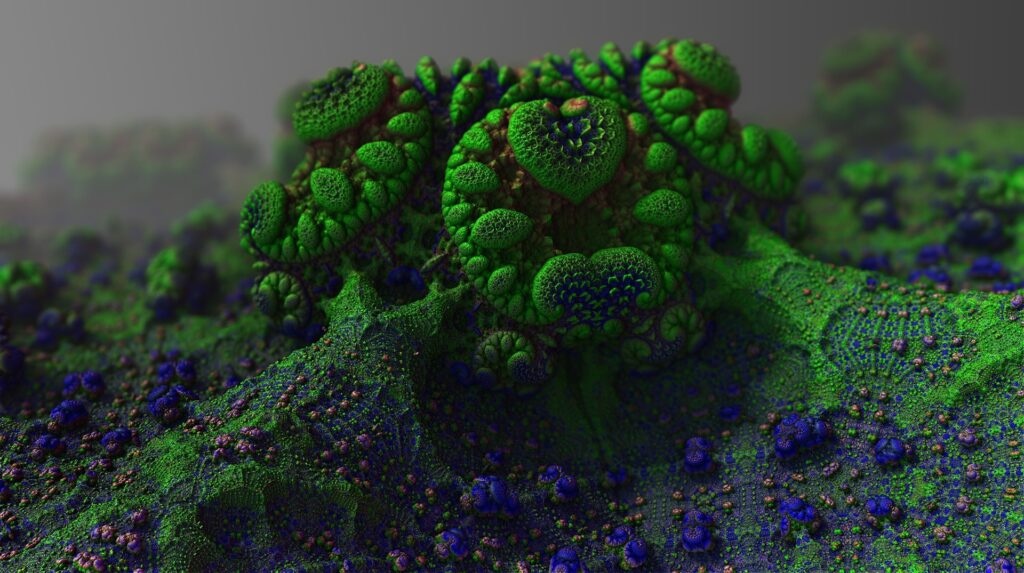
The use of colloidal silver for antibacterial purposes has been known since the late nineteenth century. Nanotechnology is a priority area for modern biomedical research and its theme is the synthesis, manipulation and use of particles between 1 and 100 nm in size. Nanocomposites are increasingly used in the field of biomedical applicability, due to their antibacterial, antifungal, antiviral, anti-inflammatory, anti-cancer and anti-angiogenic properties. The antibacterial effect is due to the inability of bacteria to develop their own mechanisms of resistance to nanocomposites, in addition, nanocomposites are also used as special carriers of pharmacological compounds through the bacterial wall. Both Gram-positive and Gram-negative bacteria have extraordinary abilities to adapt to very different environmental conditions. Applied microbiology studies have shown that E. coli bacteria are able to colonize extremophilic environments and develop antibiotic resistance mechanisms by activating only a small part of their genetic dowry. A medically sensitive aspect is immunosuppressed patients who may develop fatal bacterial pathologies. A real threat in this regard is the pathogen Listeria monocytogenes which can cause fatal infections in immunocompromised subjects. Experimental microbiology studies have reported and isolated strains of Listeria monocytogenes resistant to more than 5 antibiotics and their concentrations. The mentioned microorganisms have a high resistance to antibiotics, and the infections induced by these pathogens are extremely difficult to treat in many cases representing the main factor of death of patients. Colloidal silver is an effective and proven alternative in the fight against pathogenic bacteria. The antibacterial effects of colloidal silver have been demonstrated on several Gram-positive and Gram-negative bacterial strains (Staphylococcus aureus, Bacillus subtilis, Klebsiella pneumoniae, Pseudomonas aeruginosa ATCC27853 and Acinetobacter calcoaceticus ATCC 23055). Therefore, colloidal silver limits the direct effects induced by infections with various pathogens (micro or macro). In summary, in the fight against antibiotic resistance, colloidal silver can be an effective and long-lasting alternative against many pathogens of a viral, bacterial or fungal nature. The practical data are taken from experimental studies published in the literature.
Dr. Marius Radu
Salutifer Collaborator
Immunity with colloidal silver

Which pathogens does colloidal silver act against?
Colloidal silver is a universal means, devoid of almost any side effects, for treating a multitude of ailments. Numerous publications state that it acts against bacteria (eg staphylococci and streptococci), viruses and fungi (eg Candida albicans). These pathogens are completely destroyed within minutes by colloidal silver. Very interesting is that the “useful” bacteria in the large intestine, important for the human body, are normally stored, as colloidal silver is resorbed at the latest in the small intestine, where it is taken up in the circulatory system or lymph. However, colloidal silver can also be used in diseases whose cause is unknown or incompletely known. In recent years, the successful action of colloidal silver has been described for a huge spectrum of diseases, namely in the case of several hundred different clinical pictures. Especially at the beginning of our century, its effectiveness has been extensively examined by many renowned scientific researchers, who have published the results in well known medical journals, such as the Lancet, the Journal of the American Medical Association and the British Medical Journal. After a long hiatus, while interest in colloidal silver has declined sharply, research has resumed with great intensity in recent years. In the most diverse fields there is again a scientific concern for the healing power of silver and for the renewal of old methods, acquired knowledge and experiences. Colloidal silver can be used to treat ailments, but also preventively, as it supports and relieves the immune system.
Translation by Immun mit colloidalen Silber, Josef Pies, VAK Verlags GmbH, 2010
